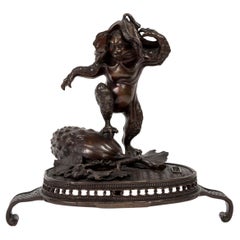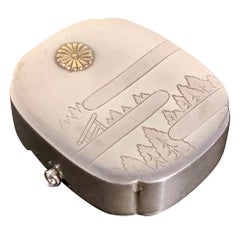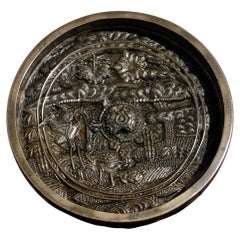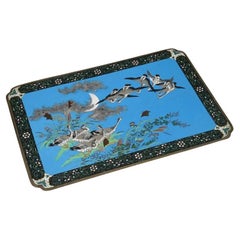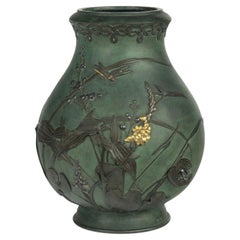Japanese Metalwork
6
615
1
1
to
106
317
212
617
616
617
6
4
3
3
1
27
339
249
2
140
44
9
19
5
9
5
3
1
6
1
606
303
171
87
83
1,483
1,076
617
418
185
17
4
3
2
2
Place of Origin: Japanese
Japanese Bronze Kappa
Located in PARIS, FR
Dark brown patina bronze figure of a standing kappa with its right leg leaning on a cucumber. The figure is put on four-legged rattan-like bronze stand.
The kappa (??) is a aquati...
Category
Late 19th Century Antique Japanese Metalwork
Materials
Bronze
Japanse Silver and Gold Bonbonniere by Mitsukoshi, Showa Era, 1935, Japan
Located in Austin, TX
A small and delightful Japanese silver bonbonniere with an applied gold Imperial Chrysanthemum Seal, marked "jungin" and "Mitsukoshi", Showa Era, 1935, Japan.
This bonbonniere is ...
Category
1930s Showa Vintage Japanese Metalwork
Materials
Gold, Silver, Sterling Silver
Japanese Cast Bronze "Longevity" Mirror, Edo Period, 18th Century, Japan
Located in Austin, TX
A heavy and finely cast Japanese bronze mirror with longevity symbols, Edo Period, 18th century, Japan.
The small, round mirror with high walls...
Category
Late 18th Century Edo Antique Japanese Metalwork
Materials
Bronze
Large Rare Meiji Japanese Cloisonne Enamel Panel of Geese Flying over the Moon S
Located in New York, NY
Large Meiji Japanese Cloisonne Enamel Panel of Geese Flying over the Moon Sky
A large antique Japanese, late Meiji era, enamel over brass wall panel. The panel is enameled with a p...
Category
Late 19th Century Antique Japanese Metalwork
Materials
Enamel, Brass
Captivating Japanese Bronze Goose Jardiniere by Seiya
Located in Christchurch, GB
As part of our Japanese works of art collection we are delighted to offer this most captivating large Meiji Period 1868-1912 bronze plant holder/ jardiniere, cast at the foundry of t...
Category
19th Century Meiji Antique Japanese Metalwork
Materials
Bronze
Meiji Period Patinated Bronze Vase by Kiryu Kosho Kaisha
Located in Lymington, Hampshire
A Meiji period patinated bronze vase by Kiryu Kosho Kaisha, the baluster body applied with gold, silver, bronze and copper designs of bogbean and arrowhead plants with a frog, dragon...
Category
19th Century Meiji Antique Japanese Metalwork
Materials
Bronze
Japanese Miyao Style Gilt Bronze Samurai Archer, Meiji Period, Japan
By Eisuke Miyao 1
Located in Austin, TX
A spectacular Japanese cast, carved, and parcel gilt bronze sculpture, okimono, of a kneeling samurai archer, signed Kiyotsugu (died 1894), Meiji ...
Category
Late 19th Century Meiji Antique Japanese Metalwork
Materials
Bronze
Japanese Bronze Group of Mice, Pumpkin and Pomegranate
Located in PARIS, FR
Polychrome bronze of a group of mice around a pumpkin and a pomegranate. The five mice have a dark brown patina, while the hollowed-out gourd is dark brown and the split pomegranate ...
Category
Late 19th Century Antique Japanese Metalwork
Materials
Bronze
Japan, Large Cloisonné Enamel Charger, Meiji Period, 19th Century
Located in PARIS, FR
Extra Large cloisonné enamel charger with a decor of butterflies among flowers on a light pink ground which is a very uncommon color.
Japan, Meiji pe...
Category
Late 19th Century Antique Japanese Metalwork
Materials
Metal, Enamel
Pair Japanese Bronze Pagoda Temple Lanterns, Taisho Period, circa 1920, Japan
Located in Austin, TX
An elegant pair of Japanese cast and lacquered bronze pagoda lanterns, Taisho Period, circa 1920, Japan.
The lanterns a true pair, with mirrored decorations and lantern doors opening in opposite directions. The lanterns of traditional toro form, cast in bronze, and lacquered. Each lantern comprised of three parts - the "roof", the "fire box", and the pedestal. This type of pedestal lantern is called a dai-doro, as opposed to the hanging lantern type, tsuri-doro.
The hexagonal roof of the lantern, reminiscent of temples or pagodas, features a wonderful, dense cloud pattern with three heart-shaped cutouts, known as inome, or boar's eye. The roof topped by a hoju, the Buddhist flaming Jewel of Wisdom. Each of the six corners feature a fantastic shachihoko, mythical beasts with the face of a tiger and body of a fish. Bells are suspended from the shachihoko.
The globular body of the lantern features four pierced panels with the three leaf hollyhock mon of the Tokugawa clan surrounded by a karakusa pattern of scrolling vines. One panel serving as a hinged door with a lock stylized as the Three Jewels...
Category
1920s Taisho Vintage Japanese Metalwork
Materials
Bronze
Japanese Komai Style Damascene Box Ashizuki
Located in Newark, England
A fine Japanese Meiji period box in the Komai style. The box of deep rectangular shape with hinged lid worked beautifully with gold and silve...
Category
Early 1900s Meiji Antique Japanese Metalwork
Materials
Metal, Gold, Silver
Japanese Cloisonne Box, Meiji Period, Late 19th Century, Japan
Located in Austin, TX
A very fine and intricately decorated Japanese cloisonné box and cover, Meiji period, late 19th century, Japan.
The lidded trinket or jewelry...
Category
1890s Meiji Antique Japanese Metalwork
Materials
Brass, Copper, Enamel
Pair of Japanese Abumi Stirrups
Located in PARIS, FR
Pair of stamped brass stirrups decorated with Hashizuka, Ito and Manabe Mons.
Japan - Edo (1615-1868), 18th century.
Height: 10.24 in. (26 cm), length: 12.6 in. (32 cm), width 4.72 in. (12 cm)
As in Western culture, the culture Japanese stirrups were part of traditional accessories...
Category
Late 18th Century Antique Japanese Metalwork
Materials
Brass
Large Japanese Bronze Monkey Vase – Hokugaku I
Located in Christchurch, GB
As part of our Japanese works of art collection we are delighted to offer this early Meiji period 1868-1912 Kaga school bronze artist signed vase, this magnificent quality piece of m...
Category
19th Century Meiji Antique Japanese Metalwork
Materials
Bronze
Japanese Cloisonne Vase with Silver Inlays by Ando Jubei
By Ando Jubei
Located in Atlanta, GA
A Japanese cloisonne vase by Ando Company circa 1910-30s, end of Meiji to Tasho period. The vase takes an archaic Chinese bronze vessel form know...
Category
1920s Meiji Vintage Japanese Metalwork
Materials
Metal, Silver
Japanese Cloisonne Enamel Chrysanthemum Vase Signed Ando Company
By Ando Jubei
Located in Newark, England
Japanese cloisonne enamel Chrysanthemum vase Tashio-early Showa period. The vase of bulbous form boldly decorated with a vivid green base enamel and...
Category
Mid-20th Century Meiji Japanese Metalwork
Materials
Silver, Enamel, Wire
Signed Japanese Steel Shakudo Damascene Box with a Shimazu Mon
Located in Philadelphia, PA
A fine antique 20th century Japanese Amita Damascene Steel Box.
Made of damascened steel inlaid with gold & silver.
The lid of the box has gilt depictions of bamboo plants, whi...
Category
20th Century Showa Japanese Metalwork
Materials
Gold, Silver, Copper, Steel
Tōkanmuri Kabuto Samurai Helmet in the Shape of a Court CAP
Located in Milano, IT
Tokanmuri kabuto
Samurai helmet in the shape of a court cap
Momoyama to early Edo Period
17th century
The wearing of helmets that reproduced the shapes of traditional ...
Category
17th Century Antique Japanese Metalwork
Materials
Iron
Large Japanese Bronze Zoomorphic Jardiniere by Seiya
Located in Christchurch, GB
As part of our Japanese works of art collection we are delighted to offer this large scale Meiji Period 1868-1912, bronze jardiniere from the foundry of the highly regarded and well ...
Category
19th Century Meiji Antique Japanese Metalwork
Materials
Bronze
Japan, Very Large Cloisonne Charger, Meiji Period 19th Century
Located in PARIS, FR
Japan, very large cloisonne charger, 19th century.
A very large charger, decorated in various coloured enamels with a crane amongst various ...
Category
Late 19th Century Antique Japanese Metalwork
Materials
Metal, Enamel
Large Pair of Meiji Period Japanese Cloisonne Enamel Vases Attributed to Goto
Located in New York, NY
A large pair of Meiji Period Japanese cloisonne enamel vases attributed to Goto Seizaburo, 19th century.
These vases were made during the Meiji period (1868-1912) in Japan and are...
Category
19th Century Meiji Antique Japanese Metalwork
Materials
Copper, Enamel
Very Large Japanese Bronze Ferry Boat Okimono by Seiya
Located in Christchurch, GB
As part of our Japanese works of art collection we are delighted to offer this most unusual large scale Meiji Period 1868-1912, bronze casting of a wooden ferry boat carrying passeng...
Category
19th Century Meiji Antique Japanese Metalwork
Materials
Bronze
Ota Jinnoei 1890 Imperial Meiji Period Pair of Cloisonne Cabinet Vases
By Ota Jinnoei
Located in Miami, FL
Pair of cloisonne vases designed by Ota Jinnoei.
Beautiful pair of small cabinet vases, created in Japan circa 1890, during the meiji Imperial period (1868-1912). These vases has ...
Category
1890s Meiji Antique Japanese Metalwork
Materials
Silver, Bronze, Enamel
Japanese Cloisonne Enamel Vase Ando Company
By Ando Jubei
Located in Newark, England
Japanese cloisonne enamel vase. The vase of ovoid form with circular opening, black enamel glaze and silver mounted rims. Boldly decorated with autumnal flowers and birds. To the top and bottom geometric patterns finish the vase.
Notes Ando Cloisonné...
Category
Early 20th Century Meiji Japanese Metalwork
Materials
Metal, Silver, Enamel
Pair of Japanese Bronze Grasshopper Vases
Located in PARIS, FR
Insects (mushi) occupy an important place in Japanese culture. Hunting for insects is a popular pastime, especially among children. Using plastic nets and cages, they catch cicadas and beetles to observe them.
Between 1830 and 1832, Hokusai composed an untitled series of ten large horizontal prints...
Category
Late 19th Century Antique Japanese Metalwork
Materials
Bronze
Japanese Bronze Vase with Butterfly Design
Located in Hudson, NY
Taisho period bronze with butterfly design and handles with wheat design.
Signature on base reads: Akijo.
Category
1920s Vintage Japanese Metalwork
Materials
Bronze
Japanese Komai Style Iron Damascene Dish by Abe Shoten
Located in Newark, England
Japanese Komai style iron damascene dish. The dish decorated with a landscape scene worked in gold and silver nunomezogan on a matt black ground with a ...
Category
Late 19th Century Meiji Antique Japanese Metalwork
Materials
Metal, Gold, Silver, Iron
Cabinet and Two Vases in Gold Damascened Iron
By Komai
Located in Saverne, Grand Est
Exceptional set composed of a cabinet and two miniature vases in gold damascened iron. The cabinet opens in front with four drawers. The three pieces are marked with Mount Fuji, signature of the artist Fujii Yoshitoyo...
Category
Early 20th Century Japanese Metalwork
Materials
Iron
Tiger Sculpture Object by a Well Known Japanese Metal Artist
Located in Fukuoka, JP
Tiger sculpture object by a well known Japanese Metal artist Saegusa Soutarou
Saegusa Soutaro ( 1912-2006 ), his works were often displayed during p...
Category
Mid-20th Century Showa Japanese Metalwork
Materials
Iron
Oriental Flowering Hawthorn Cloisonne Double Gourd Vase
Located in Bishop's Stortford, Hertfordshire
A very fine and stylish antique oriental, Chinese attributed, cloisonne double gourd vase dating from the latter 19th century. The vase stands on a flat brass base with a wide round base, pinched waist and narrow round upper section with a funnel style top with a flat metal rim. The body of the vase is decorated with a mixture of flowering shrubs dominated with flowering hawthorn incorporating a butterfly to one side. The continuous scenes are decorated in colored enamels against a bright turquoise ground and set between formal borders around the foot, the pinched centre and top of the vase. The vase is typically not marked but is a striking and very stylish example.
Provenance: Acquired from the UK art...
Category
19th Century Antique Japanese Metalwork
Materials
Metal, Enamel
Japan, Eagle and Snake, Bronze, Meiji Period
Located in PARIS, FR
A spectacular large bronze with dark brown patina representing an eagle with outstretched wings and a snake.
52x40x40cm
Japan, Meiji period.
Category
Late 19th Century Antique Japanese Metalwork
Materials
Bronze
Large Pair of Meiji Period Japanese Cloisonne Enamel Double Dragon Vases
Located in New York, NY
A large pair of Meiji Period Japanese Cloisonne Enamel Double Dragon Vases, 19th century.
Japanese cloisonne enamel dragon vases are highly ...
Category
19th Century Meiji Antique Japanese Metalwork
Materials
Copper, Enamel
Japanese Silver and Mixed Metal Koro, Artist Signed
Located in Christchurch, GB
As part of our Japanese works of art collection we are delighted to offer this super quality Meiji Period 1868-1912, pure silver and mixed metal koro or incense burner, the heavy sil...
Category
19th Century Meiji Antique Japanese Metalwork
Materials
Metal, Silver
Antique Signed Japanese Bronze Mixed Metals Butterbur Vase by Atsuyoshi / Inoue
Located in Philadelphia, PA
A fine signed antique Japanese Meiji period mixed metals vase.
By Miyabe Atsuyoshi for Inoue of Kyoto.
With a bronze body and d...
Category
Early 20th Century Meiji Japanese Metalwork
Materials
Gold, Silver, Bronze, Copper
Japanese Spear, Edo Period, Signed
Located in Stockholm, SE
A Japanese long spear. Partly lacquered wood with a forged spearhead which is signed. High quality as most of Japanese items.
Provenance: early 20th century Swedish collection.
Category
19th Century Antique Japanese Metalwork
Materials
Iron
Antique Japanese Mixed Metals Copper & Silver Usubata Ikebana Flower Vase
Located in Philadelphia, PA
A fine antique Japanese flower vase.
In hand-hammered copper (or possibly a thin-bodied bronze) with applied silver bands to rim, footrim, shaped edge, and with a lotus petal border at the joint of neck and body.
Having the usubata form with a wide flared neck and mouth.
The 'usubata' vase is a form favored for large scale floral arrangements by the Ikenobo school, the oldest and largest school of Japanese ikebana founded in the 15th century by Buddhist monk Senno Ikenobo. It is believed that the wide and shallow rim of an usubata vase which displays the surface of the water best imitates natural conditions of growth while also contributing to the longevity of an arrangement with the increased surface area of the water better oxygenating the plants.
The base retains still retains hand-hammered marks.
There is evidence of seams and folds throughout from the construction, and the surface has a cloud-like brown patina throughout.
Simply a wonderful Japanese mixed metal vase...
Category
Late 19th Century Meiji Antique Japanese Metalwork
Materials
Copper, Silver
Large Pair of Japanese Cloisonne Enamel Vases Attributed to Honda Yasaburo
Located in New York, NY
A large pair of Japanese Cloisonne Enamel vases attributed to Honda Yasaburo, 19th century.
Finley decorated with the rich enamel colors of orange and green, these vases are desig...
Category
19th Century Meiji Antique Japanese Metalwork
Materials
Copper, Enamel
Japanese Brass Incense Brazier
Located in Summerland, CA
Exceptional Japanese brass, brasier hand warmer, Circa 1890s Meiji period. Beautifully made. Round brazier has pierced cover; designed with decorative r...
Category
1890s Art Nouveau Antique Japanese Metalwork
Materials
Brass
20th Century Set of Elegant Copper Vases with Alluring Designs
Located in Fukuoka, JP
Stunning set of 3 copper metal vases with gorgeous dark plating, incised gold design. Dimensions: tallest vase - w.9cm (3.5 inches), h.25cm (9.8 inches); smallest vase - w.18cm (7 in...
Category
20th Century Japanese Metalwork
Materials
Copper
Large Pair of Japanese Cloisonne Enamel Lanterns Attributed to Kaji Tsunekichi
Located in New York, NY
A Large Pair of Japanese Cloisonne Enamel Lanterns Attributed to Kaji Tsunekichi, Edo Period, 19th century
Japanese cloisonne lanterns were made during the Meiji period, from the late 19th to early 20th century, and were often used as decorative lighting fixtures in temples and shrines.
Kaji Tsunekichi (1866-1916) was a Japanese cloisonné artist who was active in the late 19th and early 20th centuries. He was born in Tokyo and learned the art of cloisonné from his father, Kaji Sataro, who was also a cloisonné artist. He was renowned for his mastery of the shippo-yaki technique, which involves creating intricate designs with thin wires on a metal base before filling in the spaces with enamel.
Tsunekichi was known for his exceptional technical skills and his ability to create intricate designs with vibrant colors. His works often featured nature motifs, such as flowers, birds, and fish, which were rendered in a highly detailed and naturalistic style. He also experimented with new techniques, such as plique-à-jour, a type of cloisonné that creates a stained-glass effect.
Tsunekichi's works were highly prized during his lifetime and continue to be sought after by collectors today. He won numerous awards for his cloisonné creations, including a Gold Medal at the 1900 Exposition Universelle in Paris. His works are characterized by their fine wirework, precise enamel application, and attention to detail.
Some of Tsunekichi's most famous works include a pair of large cloisonné vases...
Category
19th Century Edo Antique Japanese Metalwork
Materials
Copper, Enamel
Antique Japanese Cloissone Enameled Meiji Vase with Flowers Circa 1900
Located in Big Flats, NY
An antique Japanese Meiji vase offers Cloissone enameled flower decoration, c1900
Measures- 7.5''H x 3''W x 3''D
Category
Early 20th Century Meiji Japanese Metalwork
Materials
Metal
Antique Signed Japanese Meiji Period Mixed Metals Bronze Double Gourd Form Vase
Located in Philadelphia, PA
A fine antique Japanese bronze vase.
From the Meiji Period.
With copper and silver floral and vine and butterfly inlay as well a kanji symbol to the neck (possibly a stylized f...
Category
Early 20th Century Meiji Japanese Metalwork
Materials
Silver, Copper, Bronze
Large Bronze Vase with Shishi Lions Design
Located in Fukuoka, JP
Large bronze vase with Shishi Lions design carved by Gyokusei
Age: Mid-20th Century
Dimensions: W.26 cm (10 inch) , H:36.5 cm (14.5 inch)
Wei...
Category
20th Century Showa Japanese Metalwork
Materials
Bronze
Early 20th Century, Japanese Bronze Mirror with Wooden Case and Stand
Located in Sampantawong, TH
Japanese bronze mirror with wooden case and stand.
Age: Japan, Showa Period, early 20th century
Size of mirror only: Height 40 C.M. / Diamet...
Category
Early 20th Century Japanese Metalwork
Materials
Bronze
Unique Attractive Shape Bronze Vase
Located in Fukuoka, JP
Attractive unique shape beautiful color bronze vase.
Size : diameter 8 cm (3 inch) x height 26 cm (10.2 inch)
Weight : 740g (1.6 lb)
Good condition with some minor patination ...
Category
20th Century Showa Japanese Metalwork
Materials
Bronze
Japanese Bronze and Mixed Metal Box, Signed To Base, Meiji Period
Located in Melbourne, Victoria
A rare Japanese Meiji period (1868 - 1912) circular bronze box and cover by Inoue, Kyoto, late 19th century.
The cover embossed with gilt, silvered and coppered decoration of inse...
Category
Late 19th Century Antique Japanese Metalwork
Materials
Bronze
Japanese Red Patinated Bronze Vase by Nakajima Yasumi II 二代中島保美
By Nakajima Yasumi II
Located in Amsterdam, NL
Exceptionally shaped bronze vase with a striking ‘coarse’-textured red mottled patina. The bowl subtly shaped like a flower, its slightly concave body flanked by ‘butterfly wing’-sha...
Category
20th Century Japanese Metalwork
Materials
Bronze
Japanese Wireless Cloisonné Serving Tray Meiji After Namikawa Sosuke
Located in New York, NY
A rare 19th Century Japanese copper serving tray with cloisonne enamel design. The central part of the tray depicts a wireless cloisonne picture, a coastal landscape view with a full moon. The hieroglyphical signature of the artist is in the lower right. The rims and the backside are decorated with floral ornaments. Blue and black color palette. Collectible Oriental Decor And Applied Arts For Interior Design.
Namikawa Sosuke (1847–1910) was a Japanese cloisonné artist,[1] known for innovations that developed cloisonné enamel into an artistic medium sharing many features with paintings.[2][3] He and Namikawa Yasuyuki (no relation)[notes 1] were the most famous cloisonné artists of the 1890 to 1910 period, known as the "golden age" of Japanese enamels.[1] Around 1880 he set up and ran the Tokyo branch of the Nagoya Cloisonné Company.[1] He exhibited his artworks at national and international expositions, where he took an organising role.[2] He was recognised as an Imperial Household Artist and created art works for imperial residences. He sometimes signed his works with the character sakigake (Pioneer)
the art work is based off a art work done by Sesshu Toyo
Sesshu Toyo (?? ??, c. 1420 – August 26, 1506), also known simply as Sesshu (??), was a Japanese Zen monk and painter who is considered a great master of Japanese ink painting. Initially inspired by Chinese landscapes, Sesshu's work holds a distinctively Japanese style that reflects Zen Buddhist aesthetics.[1] His prominent work captured images of landscapes, portraits, and birds and flowers paintings, infused with Zen Buddhist beliefs, flattened perspective, and emphatic lines.[2]
Sesshu was born into the samurai Oda family (???) and trained at Shokoku-ji temple in Kyoto, Japan, as a Zen monk.[1] From his early childhood, Sesshu showed a talent for painting and eventually became widely revered throughout Japan as a wise, reputable Zen scholar, and the greatest painter priest of Zen-Shu.[3]
Sesshu worked in a painting atelier whilst training under Tensho Shubun (c. 1418–1463). But upon visiting China, his work betook a distinctive Chinese influence, merging Japanese and Chinese styles to develop his individualistic style of Zen paintings.[3] Sesshu's influence on painting was so wide that many schools of art appointed him their founder.[4] Sesshu's most acclaimed works are Winter Landscape (c. 1470s), Birds and Flowers (1420–1506) and Four Landscape Scrolls...
Category
Late 19th Century Antique Japanese Metalwork
Materials
Copper, Enamel
Unique Design Japanese Hand-Hammered Copper Vase by Kyuhodou
Located in Fukuoka, JP
Unique design Japanese hand-hammered copper vase by Kyuhodou
Dimensions: 20 cm , ( 7.8 inch) H.27 cm (10.6 inch),
Weight : 1.2kg (2.6 lb) with original wooden box 1.9kg ( 4.2lb )
Lacquer display stand...
Category
20th Century Showa Japanese Metalwork
Materials
Copper
Pair of Antique Japanese Cloisonne Vases with Floral Decoration & Wooden Stands
Located in Hamilton, Ontario
This pair of vases are unsigned, but presumed to have originated from Japan and date to approximately 1920 and done in an Anglo-Japanese style. The vases are done in engraved brass w...
Category
Early 20th Century Anglo-Japanese Japanese Metalwork
Materials
Brass
Japan Meiji 1900 Three Bronze Ducks Sculpture in Wood Stand and Coral
Located in Miami, FL
Sculptural composition of the ducks from the Japanese Meiji Period.
Beautiful and very well realized sculptural composition of three ducks, made during the japanese imperial perio...
Category
Early 1900s Meiji Antique Japanese Metalwork
Materials
Coral, Bronze
Modern Lacquer Vase with Original Signed Box by Wajima Senshudo
Located in Fukuoka, JP
Gorgeous Contemporary Lacquer Vase with Original Signed Box.
Dating from the Showa period in the 20th century, this stunning piece is crafted by the renowned Japanese artist Wajim...
Category
20th Century Showa Japanese Metalwork
Materials
Lacquer
Japanese Three Garden Rabbits Family, Usagi
Located in South Burlington, VT
From our recent Japanese acquisitions and coming from a Japanese collector of rabbit usagi sculptures
Rabbit family trio (3) seated rabbit sculptures hand cast and hand painted
This is an unusual Japanese one-of-a-kind group in both large and small scale
Quality: Hand cast with carved ears...
Category
Mid-20th Century Showa Japanese Metalwork
Materials
Bronze, Iron
Japanese Meiji Bronze Basketweave Pattern Sake Pot
Located in Bishop's Stortford, Hertfordshire
An exceptional quality Japanese Meiji bronze sake pot decorated with a basket weave patterning dating between 1868 and 1912 and probably made around 1890. The...
Category
1890s Meiji Antique Japanese Metalwork
Materials
Bronze
A Fine Pair of Japanese Cloisonne Enamel Vases Attributed to Hayashi Kodenji
Located in London, GB
A Exquisite Pair of Japanese Cloisonne Enamel Vases Attributed to Hayashi Kodenji.
Meiji period 19th Century
A Fine Pair of Japanese cloisonné ename...
Category
Late 19th Century Antique Japanese Metalwork
Materials
Enamel
A Fine Pair Pair of Japanese Cloisonne Enamel Oviform Vases. Meiji period.
Located in London, GB
A Magnificent Pair of Japanese Cloisonne Enamel Oviform Vases 19th Century
Meiji period
A Pair of Japanese cloisonné enamel oviform vases worked with silver wire and decorated wit...
Category
Late 19th Century Antique Japanese Metalwork
Materials
Enamel
Owl on a Tree Stump
Located in PARIS, FR
Bronze sculpture representing an owl on a tree stump covered with ivy. The owl, detachable from its base, has shakudo eyes. It is certainly an Ryûkyû scops ...
Category
Late 19th Century Antique Japanese Metalwork
Materials
Bronze
Mid-19th Century Meiji Period Bronze Hand Mirror
Located in Chapel Hill, NC
Mid-19th century Meiji period bronze hand mirror. Floral decoration with artist inscription & signature amongst the water lillies.
Measures: 9 3/...
Category
Mid-19th Century Meiji Antique Japanese Metalwork
Materials
Bronze
Recently Viewed
View AllMore Ways To Browse
Arabic Pot
Asian Round Brass Tray
Meiji Plaque
Antique Copper Tray Round
Japanese Iron Teapot
Iron Japan Teapot
Copper Incense Burner
Brass Incense Burner Antique
Shang Dynasty Bronze
Stirrup Japan
Cloisonne Incense Burner
Antique Vajra
China Brazier
Chinese Brazier
Chinese Antique Censer
Tibet Bell
Cast Iron Teapot
Cloisonne Horse
